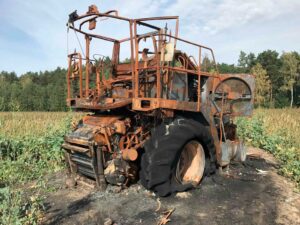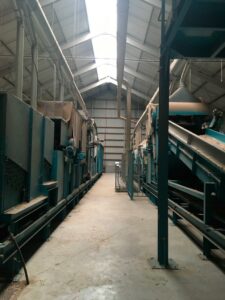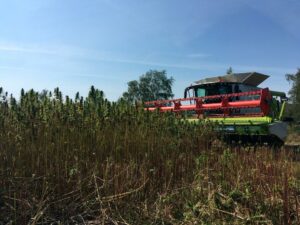As 2021 unfolds we will see the installation of a number of decortication systems in the U.S. This is exciting and great news as the industry continues to develop products that are more sustainable, can help sequester carbon, and replace petroleum-based materials. Problems are being solved; supply chain solutions to process hemp stalks are emerging.
Written for Hemptoday as trilogy by Robin Destiche the Hempoint operation director, February 2021.
Of course, that supply chain starts with buying seed for fiber hemp varieties, which requires some preliminary conversation before the purchase, aside from the details on the seed itself.
Purchasing seed is only the most fundamental part of the process. It’s not necessarily easy, but a responsible seed broker is interested in the success of the buyer, so he’ll work with you, quiz you, advise you and stick with you through the harvest. That being said, is the buyer prepared for the farming, the harvesting, the decortication and the processing of the material?
Harvesting & decortication
Creating a functional financial model for a decorticator, which sits at the heart of any fiber operation, is challenging. The end must come first: What is the target industry or product? Who are the customers? What are the annual amounts needed? How much monthly? What about quality requirements, packing, shipping? Is there potential for a second output from the hemp? What is the viable financial model for your region? How diverse should your client portfolio be?
These questions must be answered by each individual buyer, there is no “right” answer for any one project or product. It’s in the process of studying markets and developing a financial model that you’ll find clarity regarding the type of machine needed.

Taking another step backwards in the supply chain, the harvest also requires a hard look at practical considerations. Harvesting hemp for fiber requires specialized machinery. How much can your machine harvest per day: 50 acres? 75? How are you going to handle those 12-foot plants? How about millions of those plants densely grown? How much downtime for service on your equipment? What’s the backup plan if the harvester goes down? What about baling, and storage?
This is the due diligence of financial planning, but it all traces back to that fundamental matter of which seed you choose to grow.
Case study
To feed one machine with output capacity of 5 tons per hour running two shifts a day requires 20,000+ tons of input material. At 5 tons yield of hemp stalk per acre, that’s around 4,000 acres (6.25 square miles). At a fiber density planting of 50 lbs of seed per acre, that’s 200,000 pounds — 100 tons! — of seed just for one decortication line.

2,5 tons of hemp stem an hour
To secure 100 tons of seed for planting will require partnerships to be formed working with experienced seed suppliers who can help to secure future supply. The long game will be to find the varieties that will perform consistently in the different climates in the U.S. and create partnerships for multiplication to cover U.S. needs.
So where does 100 tons of planting seed for hemp fiber come from? Europe.
While the U.S. has no shortage of CBD planting seed suppliers, fiber hemp varieties are more difficult to come by. That is to say, dependable, certified seed that can be traded internationally under Organization for Economic Co-operation and Development (OECD) requirements.
That means most industrial hemp seed varieties for fiber are being sourced from Europe, which has the longest experience in fiber hemp cultivation with varieties that meet requirements of low THC (under 0.3%) required by the U.S. Department of Agriculture (USDA). In the coming years, there is no doubt that Atlantic partnerships will be created to supply the growing U.S. market with hemp for industrial use at scale.
Recent changes in Europe
Europe looks poised to continue its dominance in the fiber hemp seed market after the European Commission agreed late last year to raise the THC limit for industrial hemp in EU member states from 0.2% to 0.3%.
First, while the new limit isn’t likely to take effect until 2023, the change can be expected to immediately spur research into more advanced fiber varieties. Also, it is likely to lead to the re-animating of a number of existing high-yield cultivars from northern and eastern Europe that have been dormant because they exhibit THC levels beyond 0.2% (but less than 0.3%).
As the EU’s biggest hemp cultivation seed developer and grower, France is best positioned to reap the benefits of the changes in THC limits, having developed fiber hemp strains throughout the 1980s and 1990s for the paper making and construction sectors, and benefitting from robust research in genetics.
European system
European hemp varieties are trialed and independently tested by government institutions of EU member states for 2-3 years before they can be registered in the EU Plant variety database. Once registered under EU marketing requirements, the registration is valid for ten years. At the end of the ten-year period the custodian of the variety must apply for an extension.
Seventy-two hemp varieties, registered in 12 different countries, are listed in the EU plant variety database, or catalog; four of those varieties are registered in multiple EU countries. Varieties can be registered in one country and, thanks to common EU policy, be grown in another.
| Country | No. varieties |
|---|---|
| Hungary | 15 |
| France | 13 |
| Poland | 11 |
| Romania | 10 |
| Italy | 9 |
| Netherlands | 7 |
| Latvia | 3 |
| Slovenia | 2 |
| Spain | 2 |
| Czech Republic | 2 |
| Finland | 1 |
| Lithuania | 1 |
There are an additional 30 varieties on the EU registry that have been deleted for further market use. Varieties can be deleted for a number of reasons: 1) the custodian of the variety no longer wants to maintain the cultivar; 2) the registration deadline is not met; 3) there are differences in the seed material that no longer meet qualifications to be registered; 4) THC amounts are no longer within acceptable levels.
These varieties can be grown in Europe barring any local regulations. Not all of the varieties are commercially available; some are just maintained for research or breeding purposes. Of the total list, only about 25 varieties are in position for commercial scalability.
Growing EU seeds abroad
European growing latitude is from 40-60 degrees north, on average. The northern most variety is Finola, which has a home environment above 60 degrees north, in Finland.
It is important to know how much light the plants will receive during their vegetative cycle. There needs to be a comparison of the hemp varieties’ home latitude with the proposed growing latitude. Additionally, its growing conditions in its home environment i.e., soil, water, pests, disease, etc.
The best way to learn how these varieties will do is to trial them in the proposed growing area. University agricultural research centres are generally interested to help design the trials and collect the data for evaluation. It is a matter of reaching out and cost.
Trial size crops are different for each buyer based on their capabilities to find the right variety; it is usually enough to grow a few acres.
Officials in Indiana recently warned farmers about unscrupulous hemp seed vendors they say are currently active in the state. Some growers complained about paying for seed they never received. Others reported that seeds they purchased don’t match what’s on the label.
Horror stories about hemp cultivation seed deals gone bad aren’t new. As the renewed hemp industry races ahead, unscrupulous players are always standing by ready to take advantage of the enthusiasm. Stories of seeds that produce “hot” crops with over-the-limit amounts of THC, underperform against promised yields or are otherwise deficient are common among growers.
Supplier checklist
Buying hemp planting seed can be tricky. To make sure you’re purchasing quality seeds from a qualified buyer, here are the key things you should take into consideration when evaluating suppliers:
- Is the supplier a registered distributor of hemp planting seed?
- Are they accessible? Do they communicate well?
- Are they the growers of the varieties they are offering? Or do they work directly with the breeders who produce this seed?
- Do they have access to the farming information and best practices from the breeder or owner of the seed?

At the same time, you’re carrying out your investigation of seed suppliers, you should check your local laws and regulations for information regarding which EU hemp varieties can be legally imported and grown in your state or country. Regulations for hemp cultivation and production are usually connected to drug laws, so depending on where you live, the process can be complicated.
Start the order process
Once you’ve decided on a supplier, you’re ready to start the order process. Draw up a detailed list of the varieties you wish to purchase, indicating the quantities of each. Keep in mind that supplies of certain popular varieties can be limited, so it’s good to have a backup plan that includes alternative varieties in case your first choices are not available — or place your order early!
When planning your order, be mindful that European planting seeds usually come in 25 kg. (about 55-lb.) bags. The more you purchase, the more you reduce the overall cost, as well as the shipping charges. At Hempoint, we also make seeds available in 1kg and 5kg. (~2 lbs. and ~11 lbs.) bags in addition to standard 25kg units, to support small farmers and research organisations.

of Henola variety which is one of the lower ones.
Next, submit your detailed order and request official price quotations, shipping options and approximate delivery time. Many sellers have online order forms to help you with these details. At this point in the process, a dependable supplier will be available to answer any questions about the seeds you wish to purchase. With all questions answered, the supplier will then send you an official price offer.
Payment before shipping
Once you’ve agreed on deal terms, the supplier will invoice you for all charges, including shipping costs. Bank transfers require the lowest bank fees, and are therefore the most common way to pay EU vendors. But other options may be available.
Once the supplier receives your payment, the seeds are prepared for shipping. You’ll be able to track your shipment online once the supplier dispatches it. The coronavirus has at times affected the shipping industry, causing delays and high fees, but under normal conditions transport by air freight means you can get your seeds in about two weeks. If you plan ahead, you can ship in a cargo container by vessel. Delivery time can be up to 40 days in this case, but with cost savings.
When your seeds are shipped, you will receive all shipping papers, including the phytosanitary document, which is required for import. The original phytosanitary document travels with the shipment. But it’s important you maintain your copy in case there are any questions.
Customs on your shipment is taken care of by an agent. The supplier can arrange the shipping agent, or you can do it from your side. Be prepared to have your shipment delivered, or pick it up promptly once it arrives at any central transit station. It’s possible to get caught with storage charges if it’s not clear to the shipper what should happen to the shipment before reaching its final destination. Just be sure to know who is doing what.
‘Seed of Hope’
As a vendor of legacy European certified hemp seed, our goal goes beyond business to the mission of spreading this incredible plant all over the globe. And it’s happening. Our company has shipped hemp planting seeds to more than 30 countries in the past four years — across Europe, and to Africa, North America and South America!
If hemp is to reach its full potential, we need companies and organisations that will not only farm hemp, process it into products and create markets, but who take the matter of social responsibility seriously, embracing this miraculous plant for all it can do for human health, sustainability and economic development. The simple act of buying hemp seeds is an expression of good will towards our planet. Call it The Seed of Hope.
